The Roles of Riblet and Superhydrophobic Surfaces in Energy Saving Using a Spatial Correlation Analysis
Abstract
1. Introduction
2. Experimental Layouts
2.1. Experimental Materials
2.2. Experimental Devices
2.3. Experimental Arrangement
2.4. Experimental Indexes
- Average velocity distribution
- 2.
- Turbulence intensity
- 3.
- Two-point spatial correlation of fluctuating velocity
- 4.
- Fanning coefficient
3. Results and Discussion
3.1. Average Velocity of the Boundary Layer
3.2. Turbulence Intensity on Different Surfaces
3.3. Spatial Correlation Analysis
3.4. Differential Pressure Analysis
4. Conclusions
Author Contributions
Funding
Data Availability Statement
Conflicts of Interest
References
- Liravi, M.; Pakzad, H.; Moosavi, A. A comprehensive review on recent advances in superhydrophobic surfaces and their applications for drag reduction. Prog. Org. Coat. 2020, 140, 105537. [Google Scholar] [CrossRef]
- Lee, C.; Lee, G.W.; Choi, W. Pattern flow dynamics over rectangular Sharklet patterned membrane surfaces. Appl. Surf. Sci. 2020, 514, 145961. [Google Scholar] [CrossRef]
- Bechert, D.W.; Bruse, M.; Hage, W.v. Experiments on drag-reducing surfaces and their optimization with an adjustable geometry. J. Fluid Mech. 1997, 338, 59–87. [Google Scholar] [CrossRef]
- Wu, T.; Chen, W.; Zhao, A. A comprehensive investigation on micro-structured surfaces for underwater drag reduction. Ocean. Eng. 2020, 218, 107902. [Google Scholar] [CrossRef]
- Martin, S.; Bhushan, B. Modeling and optimization of shark-inspired riblet geometries for low drag applications. J. Colloid Interface Sci. 2016, 474, 206–215. [Google Scholar] [CrossRef]
- Mamori, H.; Yamaguchi, K.; Sasamori, M. Analysis of vortical structure over sinusoidal riblet surface in turbulent channel flow by means of Dual-plane stereoscopic PIV measurement. APS Div. Fluid Dyn. Meet. Abstr. 2016, H7-004. [Google Scholar]
- Luo, Y.; Zhang, D. Experimental research on biomimetic drag-reducing surface application in natural gas pipelines. Oil Gas 2012, 38, 213–214. [Google Scholar]
- Rastegari, A.; Akhavan, R. On the mechanism of turbulent drag reduction with super-hydrophobic surfaces. J. Fluid Mech. 2015, 773, R4. [Google Scholar] [CrossRef]
- Wang, B.; Zhang, Y.; Shi, L. Advances in the theory of superhydrophobic surfaces. J. Mater. Chem. 2012, 22, 20112–20127. [Google Scholar] [CrossRef]
- Li, F.C.; Cai, W.H.; Zhang, H.N. Influence of polymer additives on turbulent energy cascading in forced homogeneous isotropic turbulence studied by direct numerical simulations. Chin. Phys. B 2012, 21, 114701. [Google Scholar] [CrossRef]
- Luo, Y.H.; Liu, Y.F. Numerical simulation of micro flow field on biomimetic sharkskin micro-grooved surface. Adv. Mater. Res. 2014, 884, 378–381. [Google Scholar] [CrossRef]
- Wang, L.; Isberg, J. Nonlinear passive control of a wave energy converter subject to constraints in irregular waves. Energies 2015, 8, 6528–6542. [Google Scholar] [CrossRef]
- Kumar, S.; Pandey, K.M.; Sharma, K.K. Advances in drag-reduction methods related with boundary layer control–A review. Mater. Today: Proc. 2021, 45, 6694–6701. [Google Scholar] [CrossRef]
- Feng, S.; Huang, J.; Shen, Q. A Hybrid Model Integrating Local and Global Spatial Correlation for Traffic Prediction. IEEE Access 2021, 10, 2170–2181. [Google Scholar] [CrossRef]
- Cheng, Z. The spatial correlation and interaction between manufacturing agglomeration and environmental pollution. Ecol. Indic. 2016, 61, 1024–1032. [Google Scholar] [CrossRef]
- Divitt, S.; Watnik, A.T. Spatial-spectral correlations of broadband speckle in around-the-corner imaging conditions. Opt. Express 2022, 30, 7169–7186. [Google Scholar] [CrossRef]
- Cecen, A.; Yabansu, Y.C.; Kalidindi, S.R. A new framework for rotationally invariant two-point spatial correlations in microstructure datasets. Acta Mater. 2018, 158, 53–64. [Google Scholar] [CrossRef]
- He, G.S.; Pan, C.; Feng, L.H. Evolution of Lagrangian coherent structures in a cylinder-wake disturbed flat plate boundary layer. J. Fluid Mech. 2016, 792, 274–306. [Google Scholar] [CrossRef]
- Ritos, K.; Kokkinakis, I.W.; Drikakis, D. Implicit large eddy simulation of acoustic loading in supersonic turbulent boundary layers. Phys. Fluids 2017, 29, 046101. [Google Scholar] [CrossRef]
- Deng, S.; Pan, C.; Wang, J. On the spatial organization of hairpin packets in a turbulent boundary layer at low-to-moderate Reynolds number. J. Fluid Mech. 2018, 844, 635–668. [Google Scholar] [CrossRef]
- Kim, T.; Shin, R.; Jung, M. Drag reduction using metallic engineered surfaces with highly ordered hierarchical topographies: Nanostructures on micro-riblets. Appl. Surf. Sci. 2016, 367, 147–152. [Google Scholar] [CrossRef]
- Rowin, W.A.; Hou, J.; Ghaemi, S. Turbulent channel flow over riblets with superhydrophobic coating. Exp. Therm. Fluid Sci. 2018, 94, 192–204. [Google Scholar] [CrossRef]
- Adrian, R.J.; Meinhart, C.D.; Tomkins, C.D. Vortex organization in the outer region of the turbulent boundary layer. J. Fuid Mech. 2000, 422, 1–54. [Google Scholar] [CrossRef]
- Ganapathisubramani, B.; Hutchins, N.; Hambleton, W. Investigation of large-scale coherence in a turbulent boundary layer using two-point correlations. J. Fluid Mech. 2005, 524, 57–80. [Google Scholar] [CrossRef]
- Wu, Y.; Christensen, K.T. Spatial structure of a turbulent boundary layer with irregular surface roughness. J. Fluid Mech. 2010, 655, 380–418. [Google Scholar] [CrossRef]
- Chang, S.W.; Yang, T.L.; Liou, J.S. Heat transfer and pressure drop in tube with broken twisted tape insert. Exp. Therm. Fluid Sci. 2007, 32, 489–501. [Google Scholar] [CrossRef]
- Wang, J.J.; Lan, S.L.; Chen, G. Experimental study on the turbulent boundary layer flow over riblets surface. Fluid Dyn. Res. 2000, 27, 217–229. [Google Scholar] [CrossRef]
- Nugroho, B.; Hutchins, N.; Monty, J.P. Large-scale spanwise periodicity in a turbulent boundary layer induced by highly ordered and directional surface roughness. Int. J. Heat Fluid Flow 2013, 41, 90–102. [Google Scholar] [CrossRef]
- Xu, M.; Grabowski, A.; Yu, N. Superhydrophobic drag reduction for turbulent flows in open water. Phys. Rev. Appl. 2020, 13, 034056. [Google Scholar] [CrossRef]
- Daniello, R.J.; Waterhouse, N.E.; Rothstein, J.P. Drag reduction in turbulent flows over superhydrophobic surfaces. Phys. Fluids 2009, 21, 085103. [Google Scholar] [CrossRef]
- Lee, S.J.; Lee, S.H. Flow field analysis of a turbulent boundary layer over a riblet surface. Exp. Fluids 2001, 30, 153–166. [Google Scholar] [CrossRef]
- Li, S.; Jiang, N.; Yang, S. Coherent structures over riblets in turbulent boundary layer studied by combining time-resolved particle image velocimetry (TRPIV), POD and FTLE. Chin. Phys. B 2018, 27, 104701. [Google Scholar] [CrossRef]
- Hutchins, N.; Marusic, I. Large-scale influences in near-wall turbulence. Philos. Trans. R. Soc. A Math. Phys. Eng. Sci. 2007, 365, 647–664. [Google Scholar] [CrossRef]
- Bourdon, C.J.; Dutton, J.C. Planar visualizations of large-scale turbulent structures in axisymmetric supersonic separated flows. Phys. Fluids 1999, 11, 201–213. [Google Scholar] [CrossRef]
- Christensen, K.T.; Wu, Y. Characteristics of vortex organization in the outer layer of wall turbulence. In Fourth international symposium on turbulence and shear flow phenomena; Begel House Inc.: Danbury, CT, USA, 2005. [Google Scholar]
- Marusic, I. On the role of large-scale structures in wall turbulence. Phys. Fluids 2001, 13, 735–743. [Google Scholar] [CrossRef]
- Chen, J.; Hussain, F.; Pei, J. Velocity–vorticity correlation structure in turbulent channel flow. Journal of Fluid mechanics 2014, 742, 291–307. [Google Scholar] [CrossRef]
- Farano, M.; Cherubini, S.; De Palma, P. Nonlinear optimal large-scale structures in turbulent channel flow. Eur. J. Mech.-B/Fluids 2018, 72, 74–86. [Google Scholar] [CrossRef]
- Jiménez, J. Coherent structures in wall-bounded turbulence. J. Fluid Mech. 2018, 842, P1. [Google Scholar] [CrossRef]
- El-Samni, O.A.; Chun, H.H.; Yoon, H.S. Drag reduction of turbulent flow over thin rectangular riblets. Int. J. Eng. Sci. 2007, 45, 436–454. [Google Scholar] [CrossRef]
- Zhang, J.; Tian, H.; Yao, Z. Mechanisms of drag reduction of superhydrophobic surfaces in a turbulent boundary layer flow. Exp. Fluids 2015, 56, 1–13. [Google Scholar] [CrossRef]
- Dean, R.B. Reynolds number dependence of skin friction and other bulk flow variables in two-dimensional rectangular duct flow. J. Fluids Eng. 1978, 100, 215–223. [Google Scholar] [CrossRef]
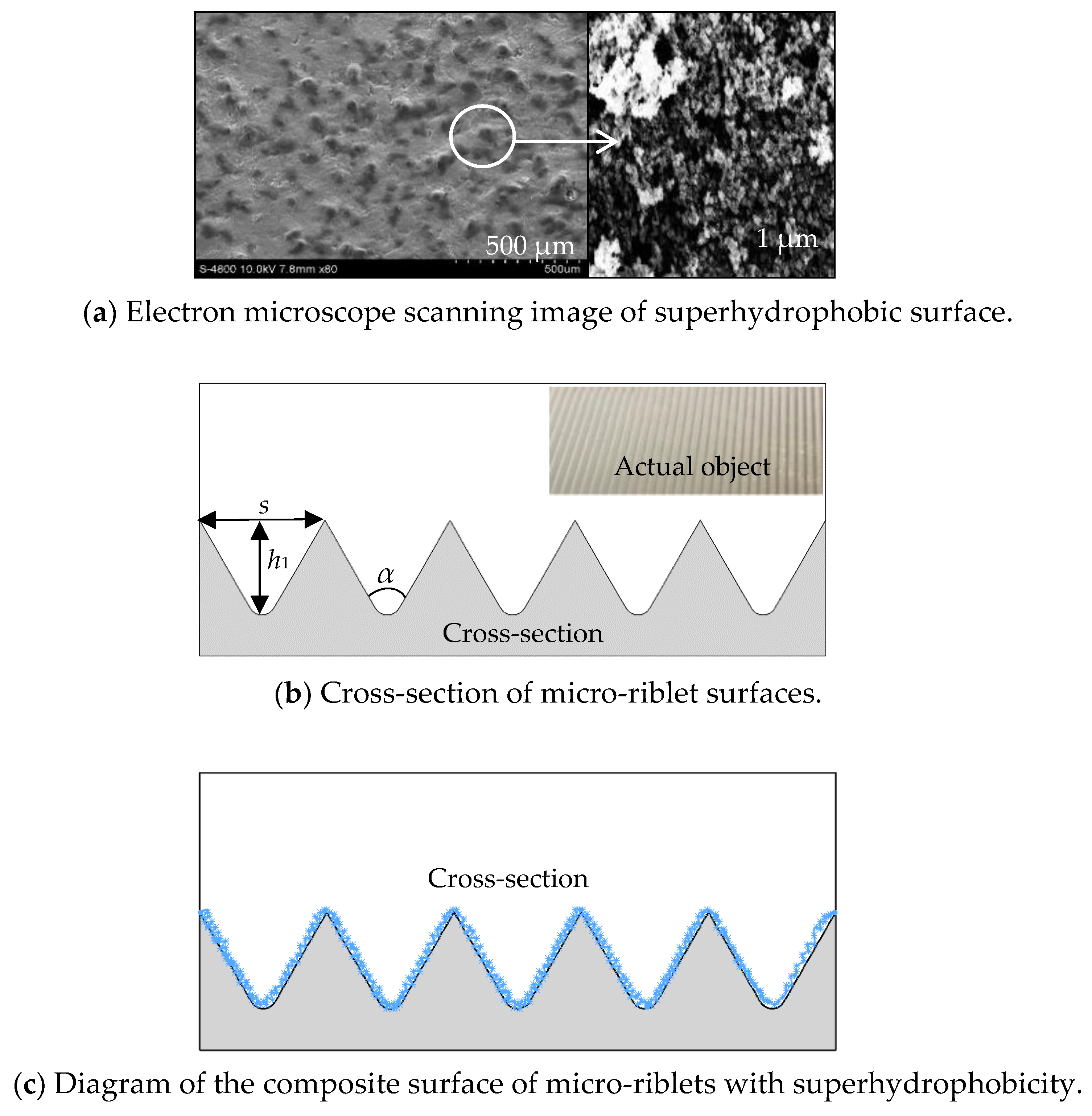
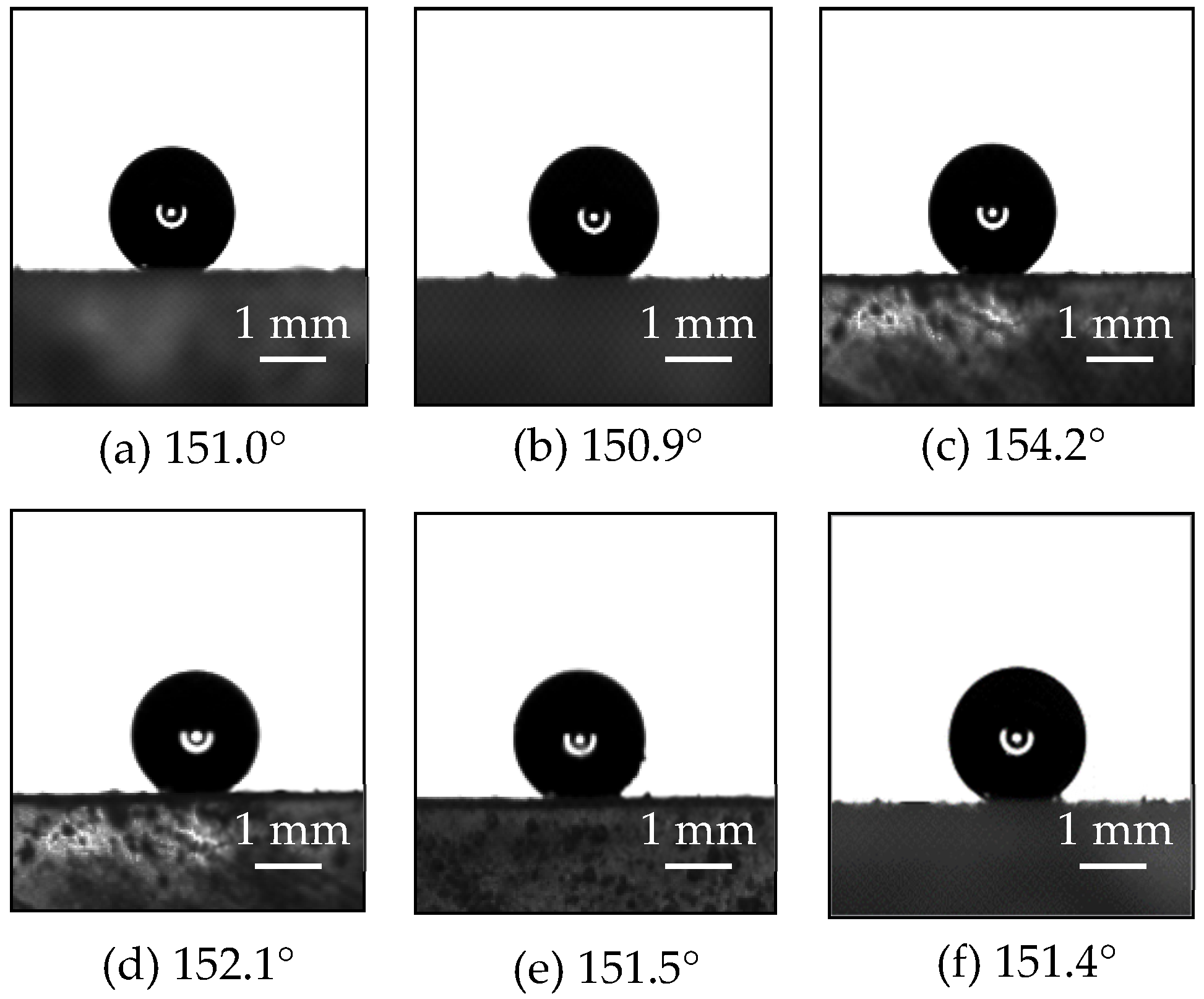
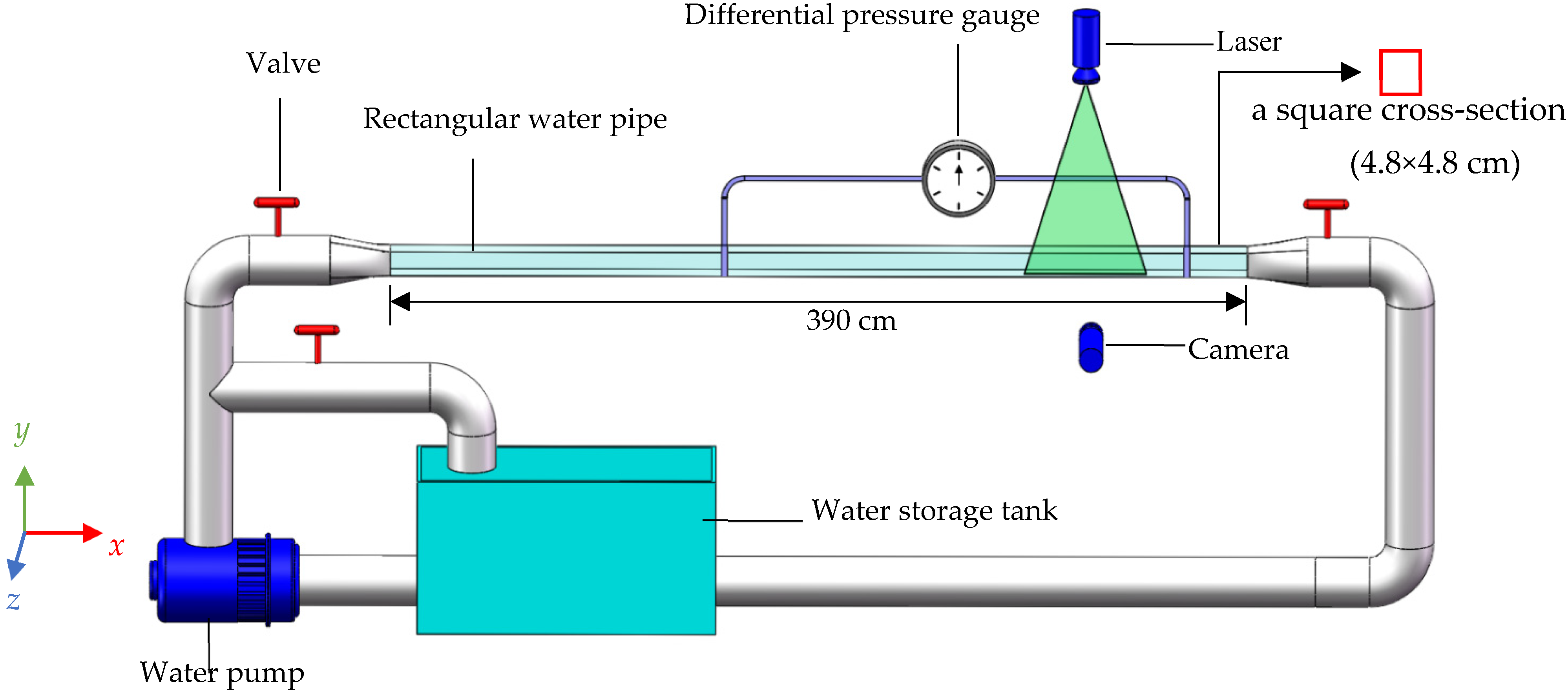
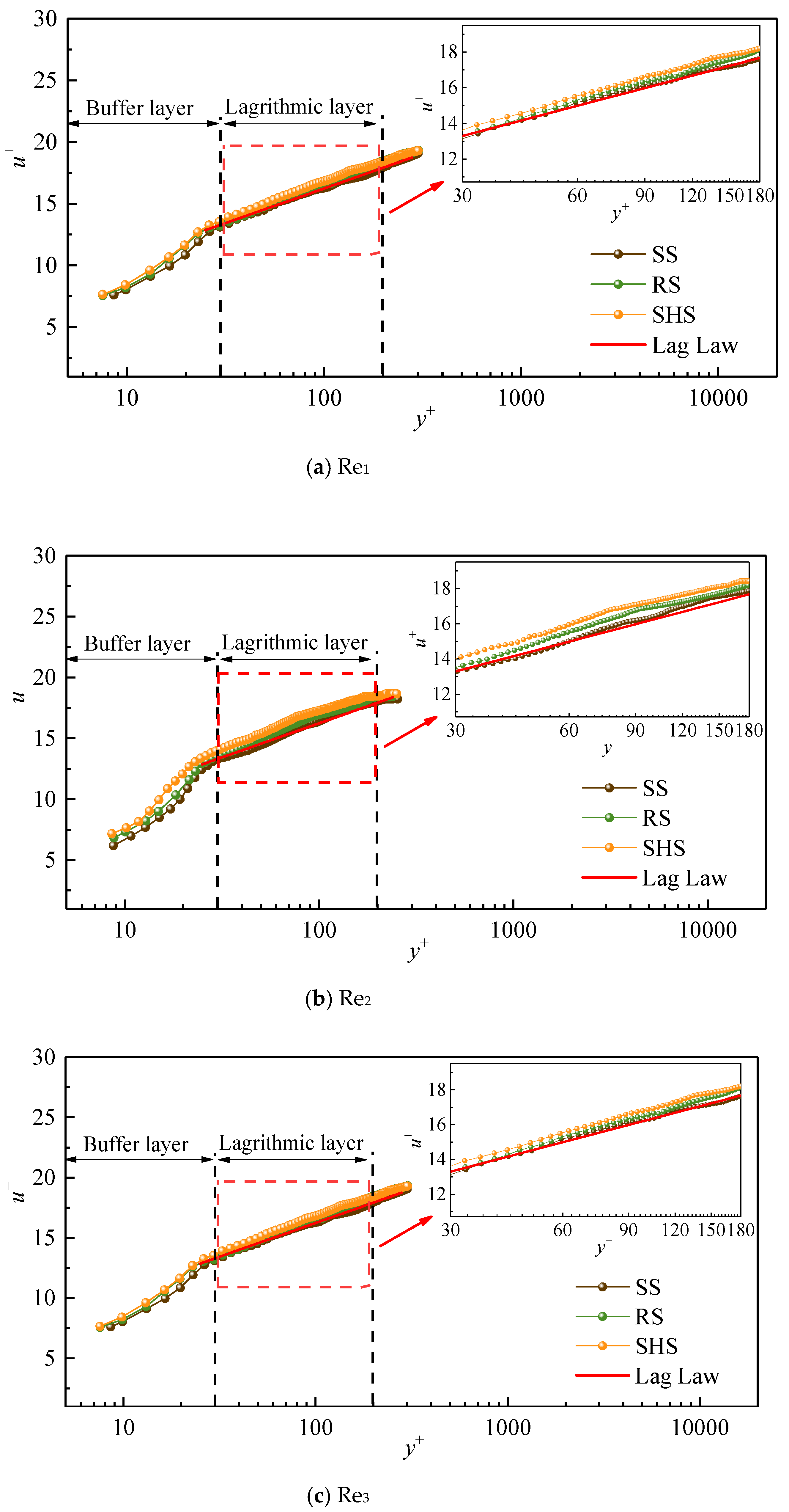
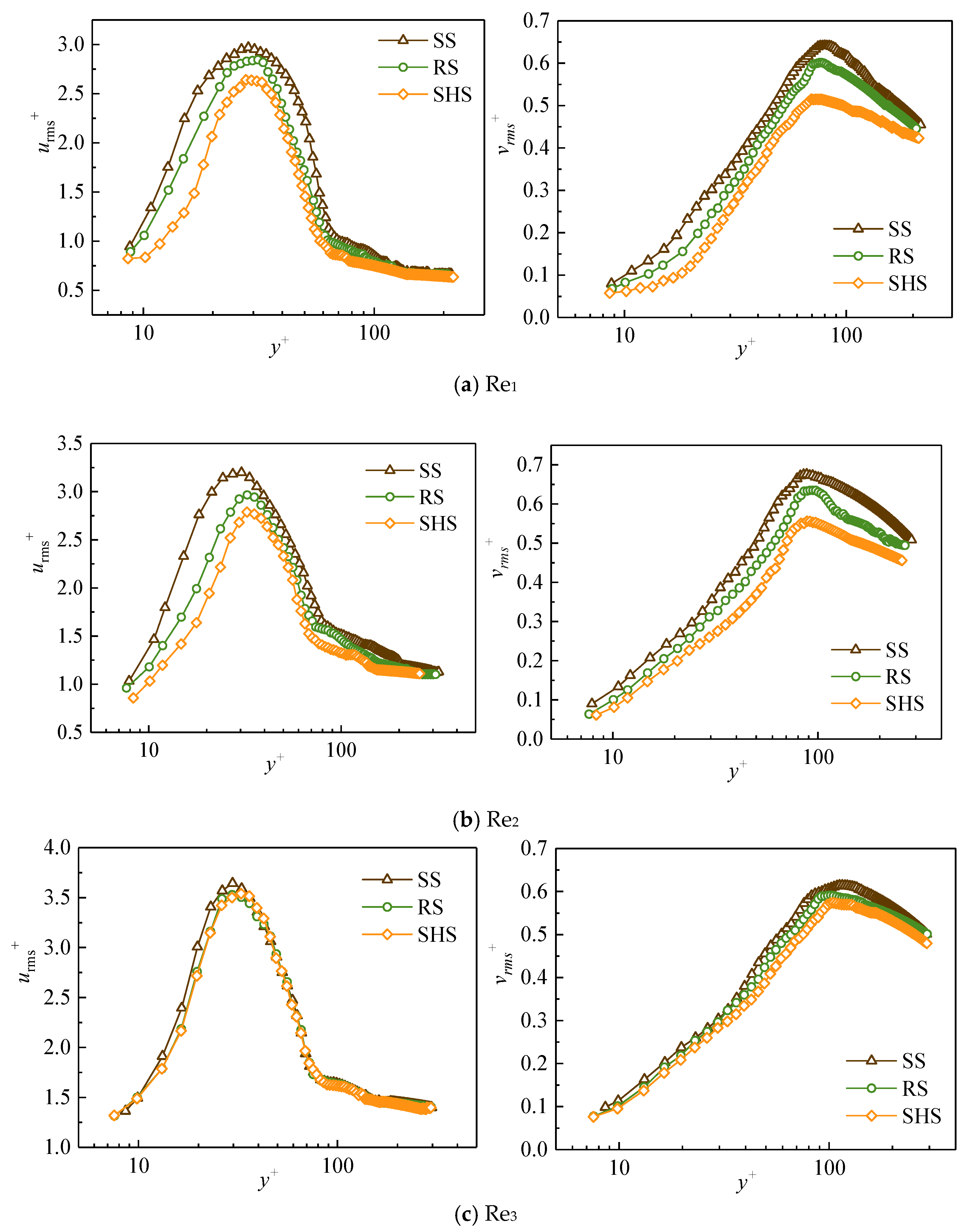
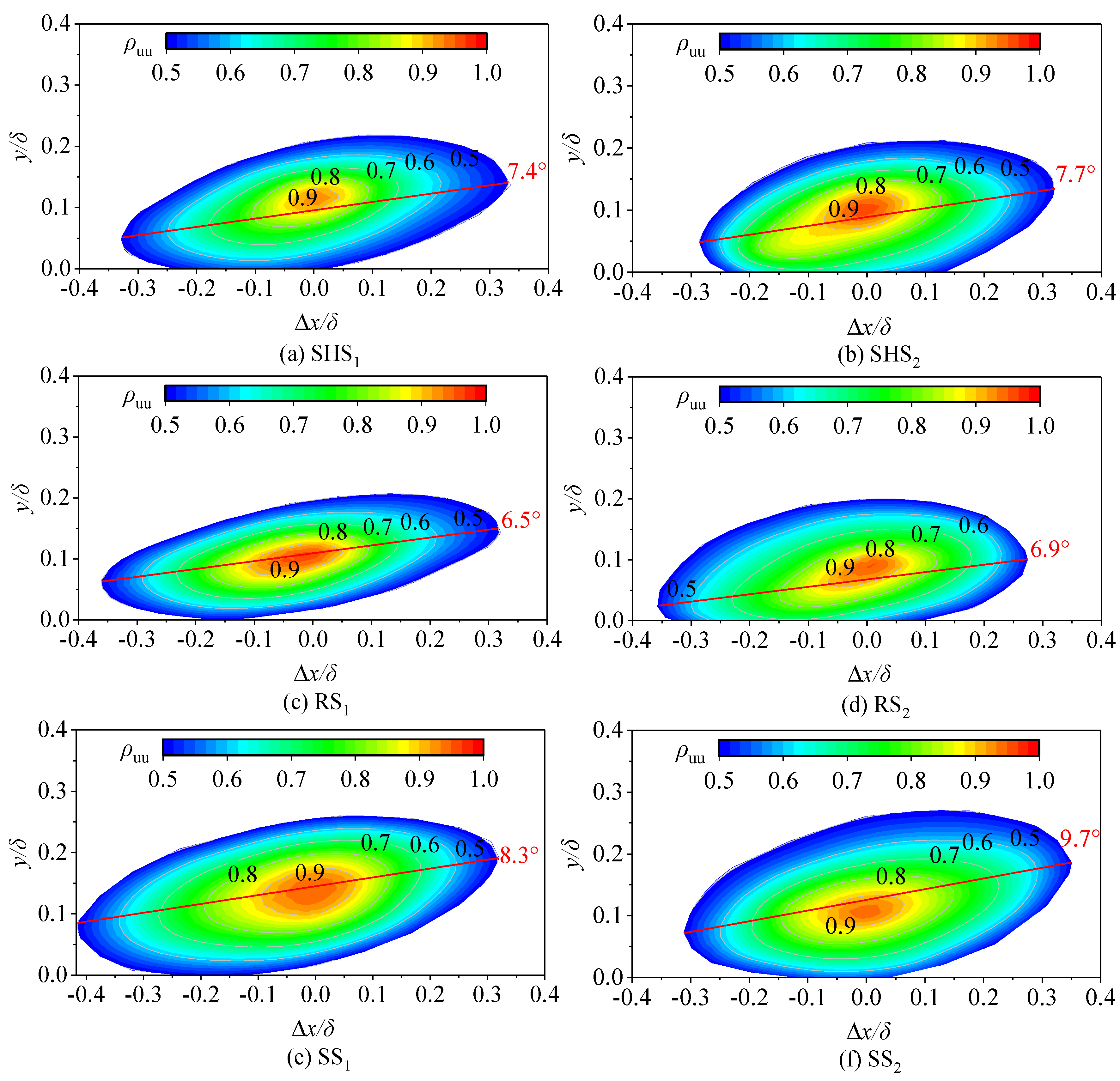
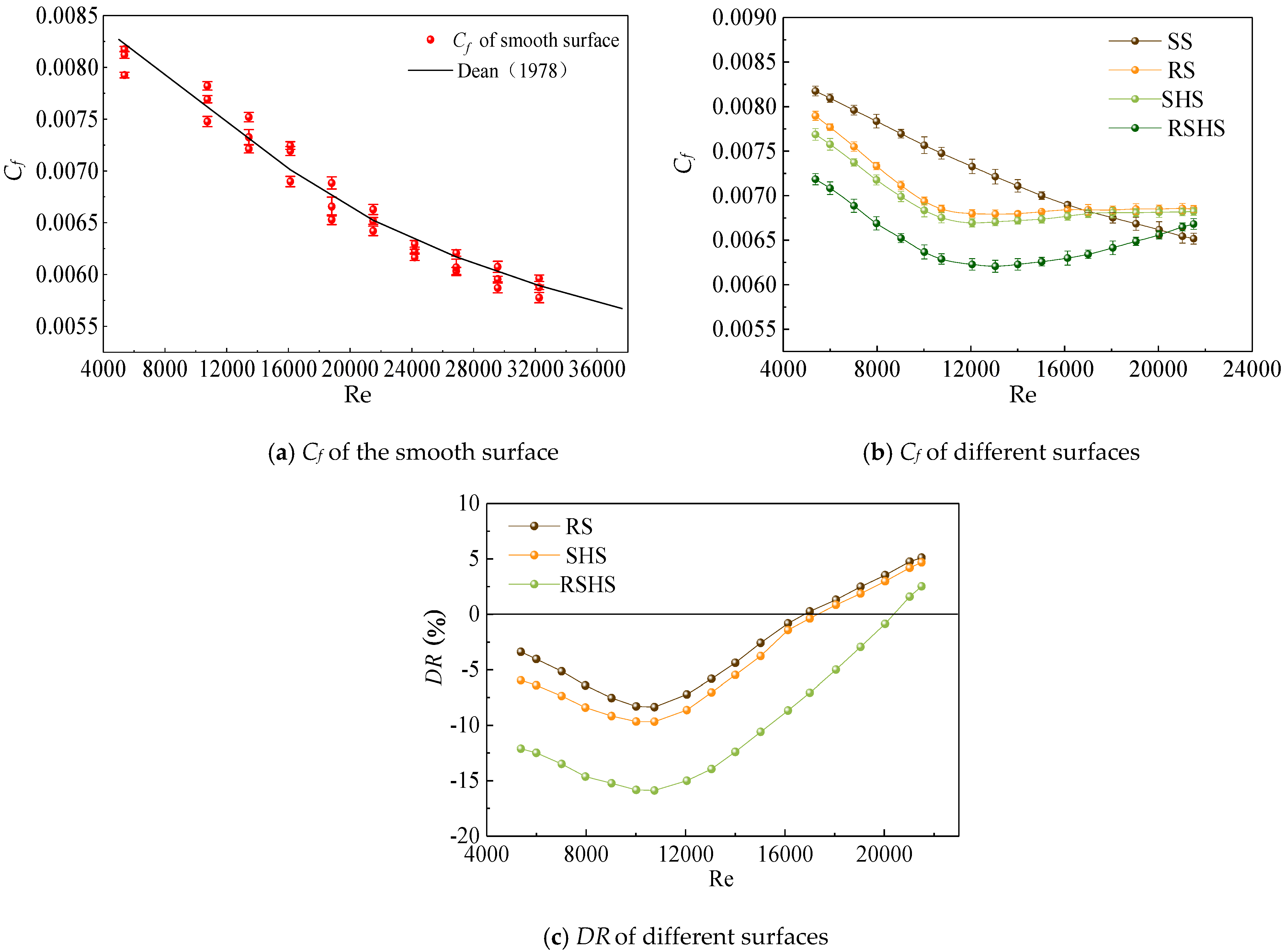
| Serial Number | Position on Surfaces | Lx | Ly | Angle/° | RLx/% | RLy/% |
|---|---|---|---|---|---|---|
| (a) | SHS1 | 0.666 | 0.214 | 7.4 | −9.75 | −17.69 |
| (b) | SHS2 | 0.608 | 0.212 | 7.7 | −8.16 | −21.77 |
| (c) | RS1 | 0.685 | 0.207 | 6.5 | −7.18 | −23.61 |
| (d) | RS2 | 0.632 | 0.200 | 6.9 | −4.53 | −18.46 |
| (e) | SS1 | 0.738 | 0.260 | 8.3 | 0.00 | 0 |
| (f) | SS2 | 0.662 | 0.271 | 9.7 | 0.00 | 0 |
Disclaimer/Publisher’s Note: The statements, opinions and data contained in all publications are solely those of the individual author(s) and contributor(s) and not of MDPI and/or the editor(s). MDPI and/or the editor(s) disclaim responsibility for any injury to people or property resulting from any ideas, methods, instructions or products referred to in the content. |
© 2023 by the authors. Licensee MDPI, Basel, Switzerland. This article is an open access article distributed under the terms and conditions of the Creative Commons Attribution (CC BY) license (https://creativecommons.org/licenses/by/4.0/).
Share and Cite
Liu, C.; Wang, W.; Hu, X.; Fang, J.; Liu, F. The Roles of Riblet and Superhydrophobic Surfaces in Energy Saving Using a Spatial Correlation Analysis. Nanomaterials 2023, 13, 875. https://doi.org/10.3390/nano13050875
Liu C, Wang W, Hu X, Fang J, Liu F. The Roles of Riblet and Superhydrophobic Surfaces in Energy Saving Using a Spatial Correlation Analysis. Nanomaterials. 2023; 13(5):875. https://doi.org/10.3390/nano13050875
Chicago/Turabian StyleLiu, Chunye, Wene Wang, Xiaotao Hu, Juan Fang, and Fulai Liu. 2023. "The Roles of Riblet and Superhydrophobic Surfaces in Energy Saving Using a Spatial Correlation Analysis" Nanomaterials 13, no. 5: 875. https://doi.org/10.3390/nano13050875
APA StyleLiu, C., Wang, W., Hu, X., Fang, J., & Liu, F. (2023). The Roles of Riblet and Superhydrophobic Surfaces in Energy Saving Using a Spatial Correlation Analysis. Nanomaterials, 13(5), 875. https://doi.org/10.3390/nano13050875








